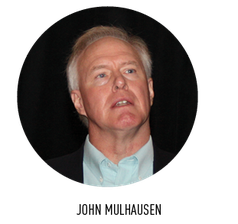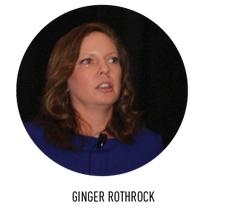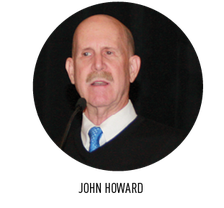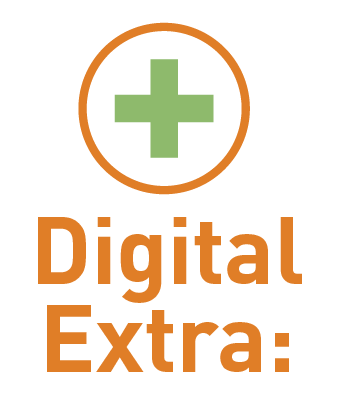In 1993, the Internet pioneer Robert Metcalf declared that the value of a network is proportional to the square of the number of connected users. Metcalf was talking about telecommunications, but his observation has become so ingrained in technological circles that it’s considered a defining principle of the Internet age.
Metcalf’s Law, as it’s now known, was a constant presence at AIHA’s Fall Conference in Orlando last October, where many speakers addressed the potential and pitfalls of our increasingly networked world. The conference highlighted many of the trends that are affecting the practice of industrial hygiene and informing AIHA’s program of work.
THE VIRTUAL VENEER
Dumpsters that let garbage collectors know they’re full. Bridges that warn drivers when ice is beginning to form. Eyeglasses that display virtual schematics of the complex machinery you’re trying to fix.
Whether coming soon (the bridges) or already here (there are dumpsters in Europe that have their own Twitter feeds), these smart machines will rapidly become familiar features of daily life. Sometime in the 2020s, according to Michael Rogers, a futurist who gave the Fall Conference keynote address on Oct. 26, every object we rely on will be connected to the Internet, endlessly adding its stream of data to the general torrent.
This phenomenon is known as the “Internet of Things” (IoT), and it’s already layering a virtual veneer over brick-and-mortar reality. “We’re in the process of what I call the virtualization of the world,” Rogers said. “All of us will be connected to the Internet all the time, either consciously through our devices or unconsciously through the objects around us.”
The implications of such a world are striking to consider. For children who grow up in the IoT era, Rogers said, a temporary loss of Internet connection will be even more disruptive than power outages were to earlier generations, since losing Internet will be like losing half of their world. “By the early ’20s, we will have to teach kids what ‘offline’ means, because online will be the normal state of things,” Rogers said. “Everything you own will work better when it’s connected to the Internet—or maybe work at all.”
Smart glasses are one IoT application that holds promise for occupational health and safety practitioners. Wearing such a device, an OHS professional walking through a facility could access digital safety data sheets about the chemicals stored in containers, or determine whether an employee engaged in a particular task has been properly trained and is wearing the correct PPE.
Thanks to technology, the very notion of “the workplace” as distinct from other types of places will continue to diminish: driven by steady population growth, “virtual work will become much more common and popular,” Rogers said, as more workers and employers adapt to what will soon be unceasingly nightmarish traffic. (“If you think it’s crowded on the streets right now, just wait,” Rogers warned.) To younger millennials raised on Minecraft and Facebook, virtual work will seem natural. But Rogers foresees challenges in the regulatory area as corporations resist attempts to hold them accountable for the health and safety of workers in these “highly distributed” workplaces.
Rogers also predicts no relief for the beleaguered media industry, which has been unable to replace its print-based business model with something equally profitable for the digital age. He noted that traditional journalism has historically been a force for progress on issues of workplace health and safety, and journalism’s decline will force OHS practitioners into a new role when dealing with the media. “Beat reporters are not going to know as much about science, industry, and law as beat reporters 20 years ago,” Rogers said. “It’s important to recognize now that you need to be educators when you talk to the media. Opponents of workplace safety are doing their very best to provide that kind of education.”
Smyth Lecture to Be Rescheduled
Due to a family emergency, Michael Ellenbecker was unable to travel to Orlando to present his Henry F. Smyth, Jr. Award Lecture, “The Challenge of Setting Occupational Exposure Limits for Engineered Nanomaterials.” Unfortunately the attempt to hold the presentation via Skype was unsuccessful. To ensure that Ellenbecker’s achievement is properly recognized, AIHA has invited him to give his lecture on-site at AIHce 2016.



"Heaven on earth for IH would be a place where each person's exposure risk is understood and where each person's exposure risk is well managed."
IH NIRVANA
Rogers’ address helped attendees envision the broad landscape of life and work in the 2020s. Afterward, a pair of speakers offered deeper perspectives on two areas of great promise for industrial hygiene: occupational exposure banding and sensor technologies.
John Mulhausen, director of corporate safety and industrial hygiene at 3M, opened his presentation by defining what, for him, constitutes the highest aspirations of industrial hygiene. “Heaven on earth for IH would be a place where each person’s exposure risk is understood and where each person’s exposure risk is well managed,” Mulhausen said.
For Mulhausen, occupational exposure banding (OEB) is a key step toward that goal. OEB is an approach to risk management that groups chemicals into categories or “bands” based on their health outcomes and potency considerations, with each band representing a range of exposure values. The approach is considered a potentially powerful tool for IHs to use when dealing with a chemical that does not have an occupational exposure limit, as is the case for most of the hundreds of thousands of chemicals in commerce.
Citing developments in Europe that facilitate the dissemination of toxicological information and the imminent release of NIOSH’s validated OEB process, Mulhausen asserted, “We’re in an exciting place today for the use and development of occupational exposure bands.”
OSHA, too, has signaled interest in OEB. In October 2014, the agency requested information regarding new approaches to updating its outdated permissible exposure limits. OSHA’s Federal Register notice specified OEB as a potentially fruitful approach to managing chemical risks. Mulhausen expressed hope that OSHA’s interest would spur companies and OEL-setting organizations to generate more occupational exposure bands “to help us deal with all the materials out there for which we still need OELs.”
Following Mulhausen’s presentation, Ginger Rothrock, director of emerging technologies at RTI, a research organization in Research Triangle Park, N.C., told attendees that the extraordinary growth in sensor technologies over the last ten years suggests that IHs could be closer to achieving Mulhausen’s “heaven on earth” than many realize. Between 2008 and 2013, Rothrock said, there was a 222 percent increase in sensor use across all industries.
As sensors improve, so will their usefulness for safety and health applications. Among the sensor-based devices currently under development is a handheld spectroscopy instrument for monitoring food quality that could alert a user to the presence of allergens, for example. Another wearable device that measures brain waves has potential for predicting seizures; such a warning could give a seizure-prone driver time to pull to the side of the road. Other sensors are able to detect biomarkers of disease in a person’s breath.
Using such instruments could potentially allow industrial hygienists to construct individual exposure profiles with a high degree of specificity. However, Rothrock cautioned that the data available from such applications will need to be placed in proper context by knowledgeable professionals.
EMERGING ISSUES
NIOSH Director Dr. John Howard took the stage on Oct. 27 to discuss his reactions to an AIHA-commissioned research report that identified emerging issues and trends with the potential to significantly affect the industrial hygiene profession. Always a favorite at AIHA’s conferences, Howard delivered a straightforward talk that helped attendees understand how NIOSH and AIHA research priorities fit with these emerging issues.
Howard explained how global change and the pressures of capital markets are causing corporations to shed everything but their core business, leading to the “erosion” of the employer-employee relationship through increased subcontracting and sometimes serial subcontracting—types of employment that he described as “precarious.”
“We have all sorts of dual employers now, so NIOSH is largely looking at organizational factors that relate as exposure variables to the health of the individuals who are experiencing those exposures,” Howard said. Work intensification—caused by mandatory overtime and downsizing that results in more work for employees left behind—and lack of paid family and medical leave are examples of these exposure stressors.
“Twenty years ago, NIOSH studied stress as a health endpoint,” Howard continued. “Stress now is a mediator leading to a health endpoint.”
Contractors, temporary employees, and similar individuals are not sheltered by the traditional employer-employee relationship described in the Occupational Safety and Health Act. Employees who were working as contractors at the time of their fatal injury accounted for 17 percent of the total number of fatal work incidents in 2013, and Howard pointed to additional evidence that these individuals are also experiencing an increasing number of occupational injuries.
“These are becoming the people we have to concentrate on, and yet they may not be served by the profession of industrial hygiene,” he said.
As Howard shifted gears to discuss research in policy and regulation, he spoke to the idea of “wellness as an occupational issue,” which was discussed in the AIHA research report. He explained that NIOSH is trying to “marry” worker well-being and traditional safety and health, but not in the paradigm of worker wellness.
“Employers often have [employee wellness] programs where there’s no attention to the risk factors arising from work itself,” Howard said. “Lifestyle factors are important, but you have to look at the work too, so NIOSH is trying to do that.”
Howard acknowledged the work already being done on many emerging issues. Last year NIOSH launched its virtual Center for Direct Reading and Sensor Technologies to coordinate agency research and develop recommendations in the area of exposure assessment devices, and AIHA plans to hold a scientific summit on sensor technologies for industrial health and occupational health and safety in 2016.
“NIOSH and AIHA together are looking at this issue of sensors and predictive analytics,” Howard said. “We’re trying to take data statistics—historical facts about an experience in safety and health—and extract data to at least be able to figure out what may happen in the future and to try to control it.”
LEARNING TO LEAD
Later, presenters Christopher Aadnesen and Neil Hawkins teamed up to talk with attendees about what it takes to earn a high-level position within an organization. Aadnesen, executive chairman of the Georgetown Rail Equipment Company in Texas, spoke from more than 40 years’ experience in the railroad industry, which included a period as president and CEO of the Alaska Railroad Corporation. Neil Hawkins is the chief sustainability officer and corporate vice president for The Dow Chemical Company, where he has worked for 27 years. Both presenters provided advice for industrial hygienists who are seeking a leadership role.
Leaders grow out of training, skills development, networking, and hard work, Aadnesen said. But they can’t do it alone.
“One of the most important things is to find a mentor—or two or three or four,” he said.
Would-be leaders can lean on mentors for guidance during their formative years. All IHs have leadership potential, but in Hawkins’ experience, many wait too long before moving toward a leadership role. Their path to a high-level position depends largely on the choices they make in the first five to ten years of their careers—a time when most IHs are more worried about maintaining their CIH than creating leadership opportunities within their companies, Hawkins said.
“Early choices are about keeping your options open so that you have enough management experience and breadth in your company that you can continue to move up,” Hawkins said.
Industrial hygienists’ jobs require them to work with people, whether it’s convincing them to wear a respirator properly or to implement new controls to protect workers. Influencing people requires credibility, a hallmark of a successful leader, Hawkins and Aadnesen agreed.
The railroad industry provides lessons in the importance of credibility, and Aadnesen knows that trustworthiness must carry over to new leaders in the business. Railroads are responsible for the safety of their employees as well as members of the public who live alongside the tracks. Contact with so many people requires careful management and workplace hazard identification, and the empowerment of leaders.
“The focus on safety has to be so ingrained in company culture that whoever comes in as a leader has exactly the same message going forward,” Aadnesen said.
Still missing from the skill set of many industrial hygienists and EHS professionals is the ability to “sell” the value of the services they provide for a company, Hawkins said.
“We’re still not that good about selling value—at least in my firm,” he continued. “That’s a key leadership skill that we need to instill more in the training of IHs and EHS professionals.”
THE CONVERSATION CONTINUES
Next year’s Fall Conference will be held Oct. 24–25, 2016, in San Antonio, Texas. PDCs will take place Oct. 22–23, and on Oct. 26. For more information, visit www.aihafallconference.org.
KAY BECHTOLD is assistant editor of The Synergist. She can be reached at kbechtold@aiha.org or (703) 846-0737.
ED RUTKOWSKI is editor in chief of The Synergist. He can be reached at erutkowski@aiha.org or (703) 846-0734.
AIHA’s Fall Conference Highlights Trends in Technology
The Network Effect
BY KAY BECHTOLD AND ED RUTKOWSKI

Lunch Panel Addresses Context in Risk Assessment
Click or tap icon to view media.
thesynergist | TOC | NEWSWATCH | DEPARTMENTS | COMMUNITY
The Network Effect
AIHA’s Fall Conference Highlights Trends in Technology
BY KAY BECHTOLD AND ED RUTKOWSKI

Lunch Panel Addresses Context in Risk Assessment
Tap on icon to view media.

